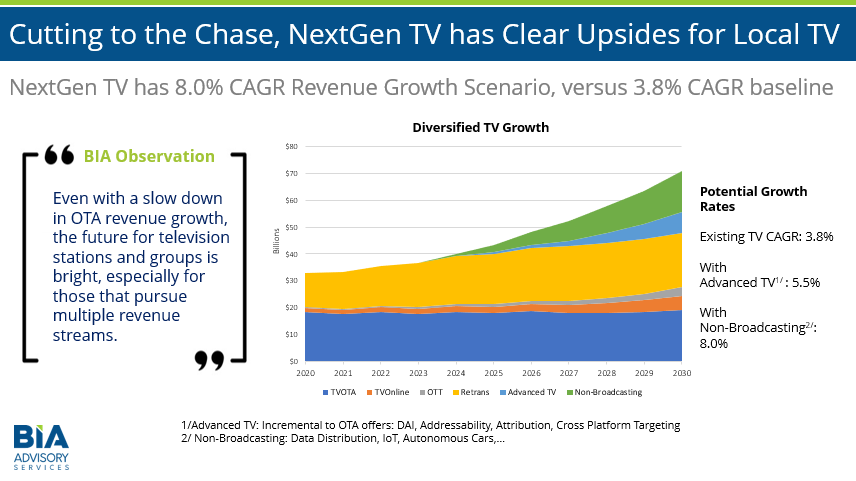NextGen TV Could Fuel 50% Local TV Revenue Growth Over 10 Years, Says BIA
CHANTILLY, Va.—NextGen TV offers clear upsides for local TV stations, which have the potential to grow revenue 50% over the next 10 years as they deploy ATSC 3.0, says a new BIA forecast.
The outlook for 3.0, presented Jan. 16 at SMPTE Washington, D.C., Chapter’s NextGen TV Summit, finds that with advanced TV the compounded annual growth rate for local broadcasters has the potential to reach 8%, compared to a 3.8% CAGR baseline.

“While a number of questions remain, there are clear upside scenarios for local TV groups investing in NextGen TV,” said BIA Managing Director Rick Ducey. “Consumer side revenue business models will take longer to scale, but business and government business models can scale much faster.”
BIA pointed out that the transition to NextGen TV for broadcasters is voluntary and the rollout of ATSC 3.0 will be done on a market-by-market basis. Thus, consumer-based business models will have a longer adoption curve.
However, NextGen TV corrects shortcomings local TV has as an advertising platform relative to competitors, the forecast pointed out. Interactivity, addressability, dynamic ad insertion, mobile, attribution and first-party data support are all benefits NextGen TV offers that strengthen local TV.

While NextGen TV offers new revenue sources, commercials and retrans will continue to be important revenue sources, said BIA Senior Vice President and Chief Economist Mark Fratrik.
“Even with the new capabilities NextGen TV provides, traditional linear TV advertising and retransmission will continue to account for the lion’s share of revenues throughout the 2020s,” he said.
Get the TV Tech Newsletter
The professional video industry's #1 source for news, trends and product and tech information. Sign up below.
Still, NextGen TV will prove to be an important initiative. “NextGen TV represents an historically significant thrust by local TV broadcasters to establish themselves as an internet-native, mobile first, advanced TV capable distribution platform,” said Ducey.
To download the forecast visit the BIA Advisory Services website.
For a comprehensive source of TV Technology’s ATSC 3.0 coverage, see ourATSC3 silo.
Phil Kurz is a contributing editor to TV Tech. He has written about TV and video technology for more than 30 years and served as editor of three leading industry magazines. He earned a Bachelor of Journalism and a Master’s Degree in Journalism from the University of Missouri-Columbia School of Journalism.

